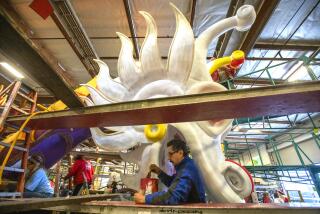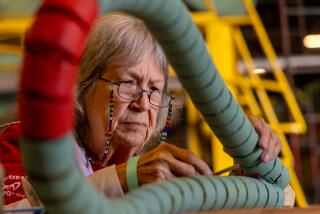Float Builders Stick to ‘Glue Man’
“Hey! Glue Man!”
The eyes of South Pasadena’s teenage float decorators turn toward a Santa Claus look-alike emerging from a glue-white 1988 Nissan pickup. Soon, the man is surrounded and showered with hugs and kisses before he can break free and pose his favorite question:
Is everything sticking together?
Bob Dickey, an 80-year-old who appears two decades younger, is the Rose Parade’s glue consultant. To frantic decorators working late at night, he is a human adhesive, the rare parade figure who binds the competing float builders with reassurances that come Jan. 1, their creations will hold.
Each year on the day after Christmas, Dickey drives from his Carlsbad home to stay with his sister in the Alhambra house in which he grew up during the 1930s. From there, he spends evenings shuttling to every float decorating barn in the San Gabriel Valley. At his seven stops, he offers good humor and poor puns, dispenses tips on dealing with water-based adhesives in freezing temperatures, and replenishes supplies for decorators who run short.
“So, Bob, where do you keep all the horses?” jokes South Pasadena’s decorating chairman, Dave Andrews, as he helps unload four five-gallon cans from Dickey’s truck -- an emergency replenishment for the city’s 155-foot-long train float, the longest in parade history.
“That, my friend,” replies Dickey, “is a trade secret.”
“There’s just a certain mystique about glue,” said the Glue Man, who introduces himself as such to get by security at the decorating facilities. “When people find out that I do the glue, well, there’s a warm, friendly reaction.”
Though the flowers capture the public’s imagination, it is glue that remains the frantic backstage concern, a particularly sticky subject.
Glue is complicated -- there are eight major types used in the decorating process, including one formulated for Rose Parade floats. Glue is expensive -- in any float budget, it costs more than everything but labor and flowers. And glue is potentially hazardous -- some of the solvents used on flowers cause air pollution and are, except for Rose Parade use, illegal.
“There are a lot of things with glues that can go wrong,” said Jim Hynd, floral director of Fiesta Parade Floats and a longtime friend of Dickey. “It’s important to have someone there to guide you along.”
Dickey’s family moved to Southern California when he was 4; he rarely missed a Rose Parade growing up. He served in the military, became a chemical engineer, and worked for 3M and later for a glue company.
After retiring in 1986, Dickey approached a colleague from his 3M days, who owns a small adhesives company, Coral Industries Inc., in Santa Fe Springs. They decided to develop a line of glues for builders. At that point, a large glue manufacturer had served the parade. But Dickey, according to builders, was Coral’s secret weapon.
Working under a consultant’s contract with Coral that pays him a commission on glue sales, Dickey quickly made himself a staple of parade life. He not only sold glue but provided on-site advice on its application. Within a few years, Coral dominated the Rose Parade glue business.
Dickey also has helped float builders negotiate with air pollution regulators. More than a decade ago, the South Coast Air Quality Management District approved a clean-air plan that banned a number of smog-producing solvents in floral glues used for the parade. That wreaked two years of havoc, as float builders watched whole strips of flowers, secured by weaker glues, peel off their floats. Eventually, Dickey helped builders appeal to the AQMD.
The district responded with an exemption, still in effect: “The provision of this rule ... should not apply to adhesives used to glue flowers to parade floats.”
“Float building is done at a time of year, December, when we do not exceed the ozone standard,” said Sam Atwood, an AQMD spokesman. “Plus, the amount of adhesive used by Rose Parade float builders is relatively small, and gluing flowers to the float is a unique application and it may well be that an adhesive that would comply with our regulations would not do an adequate job.”
8 Types of Glue
As of Jan. 2, 2004, however, the AQMD will require that all glues in Southern California -- the parade floats are not exempt on this count -- not contain a number of toxic, chlorine-based compounds. That could cause a tweaking of several parade glue formulas.
All eight types of glue are vital, builders said, because each has a unique use. Each is known by a number.
The most common is white glue, or 4089, a moisture-resistant adhesive engineered by Dickey himself and used in the first days of decorating to laminate seeds, powders and flower petals.
Decorators also employ contact cement (4124) to attach corn husks. A rubber cement (4090) like that used by schoolchildren binds delicate petals. Mosses and ferns are attached with sticky glue (4026), which stays tacky almost indefinitely. An adhesive spray (117) is used for repair work.
Hot pan glue, which comes in pellet form, is melted to hold heavy materials.(It is so dangerous that float builders usually don’t let volunteer decorators handle it). Some builders use a quick-setting “oasis” glue -- sometimes buying it from a Coral competitor -- on certain flowers.
The piece de resistance, though, is 4137, the main glue to attach whole flowers to floats. Applied to the back of a flower, it is left to dry three or four minutes, then pressed into place.
“You have to be careful getting a lot of these glues on your hands,” said Toni Groves, a decorator on the float sponsored by Rain Bird, the sprinkler company. “Some of this stuff sticks to you and will stay with you for the rest of your life.”
Over the years, some glues -- such as formula 4091 -- were abandoned. “It burned the flowers,” said Dickey. Glue once arrived in 55-gallon drums, but fire marshals objected. Now it is shipped in five-gallon cans and then poured into foam cups or squeeze bottles for application.
By rule of thumb, builders need 125 gallons of glue per float. In 2002, Fiesta Parade Floats’ order to cover 10 floats totaled 1,400 gallons.
If such shipments prove not to be enough, Dickey -- at any time of night -- will drive to the Santa Fe Springs factory for more. And if the weather is cold -- which often means that the glue won’t hold -- he can get Coral to tweak the formula.
“I’m on call for anything,” he said. “If there’s a problem with the glue, if they run out of something, I’m around to get them the adhesive that they need.”
Starting His Rounds
Wearing jeans, a light jacket and a baseball cap with an image of the dwarf Grumpy, Dickey begins his rounds at 5 p.m. At a Duarte decorating barn, he watches closely as volunteers apply white glue to the face of Orville Wright for a float that recognizes the centennial of powered flight. At the Charisma company’s decorating tent near the Rose Bowl, he gently chides owner Larry Crain, who is down to his last 30 gallons of white glue and wants more.
“You don’t carry enough on your truck,” Crain says.
“You’re supposed to order all you need from the plant ahead of time,” Dickey replies.
On Saturday night, with no glue emergencies, Dickey is done by 9.
“We’ve got pretty much everything working the way it should,” he said.
Builders have nervously noted Dickey’s advancing years. He says he is contemplating retirement, but first must find and train a successor.
Dickey doesn’t stay for the parade. On Tuesday, when the decorating is finished, Dickey will drive home to Carlsbad. There he will watch the parade on TV.
“I see enough of the floats,” he said, “through the glue.”


